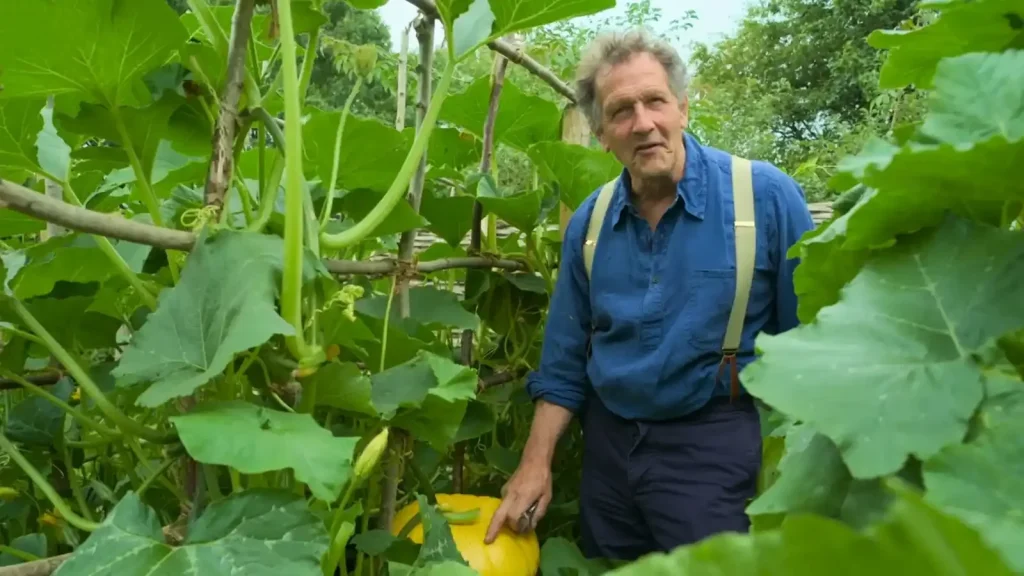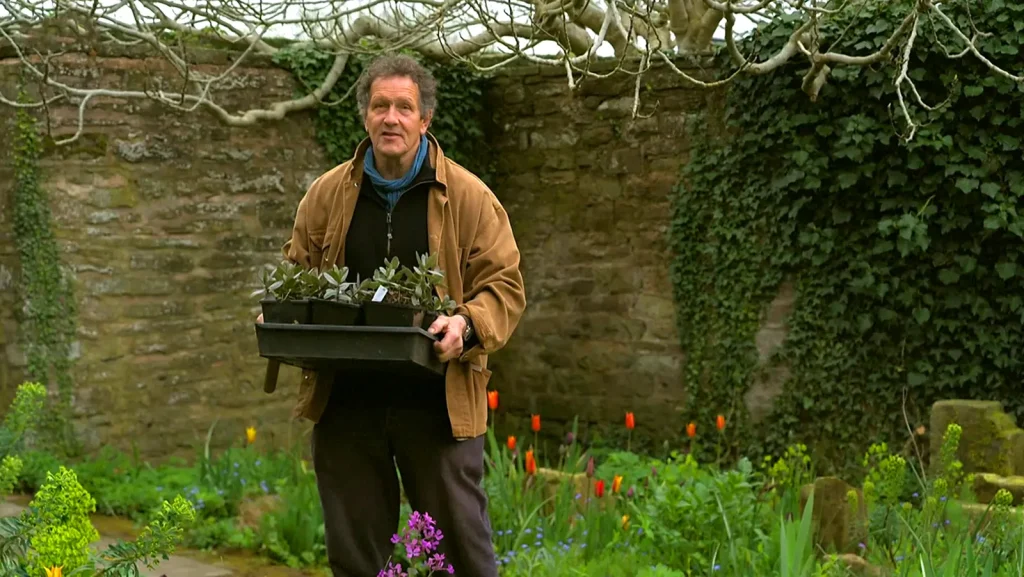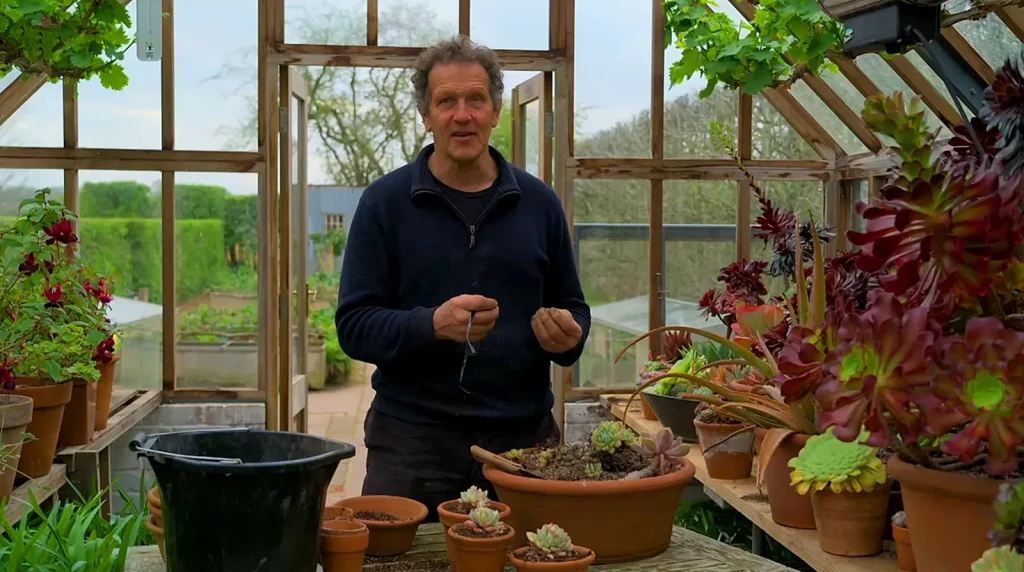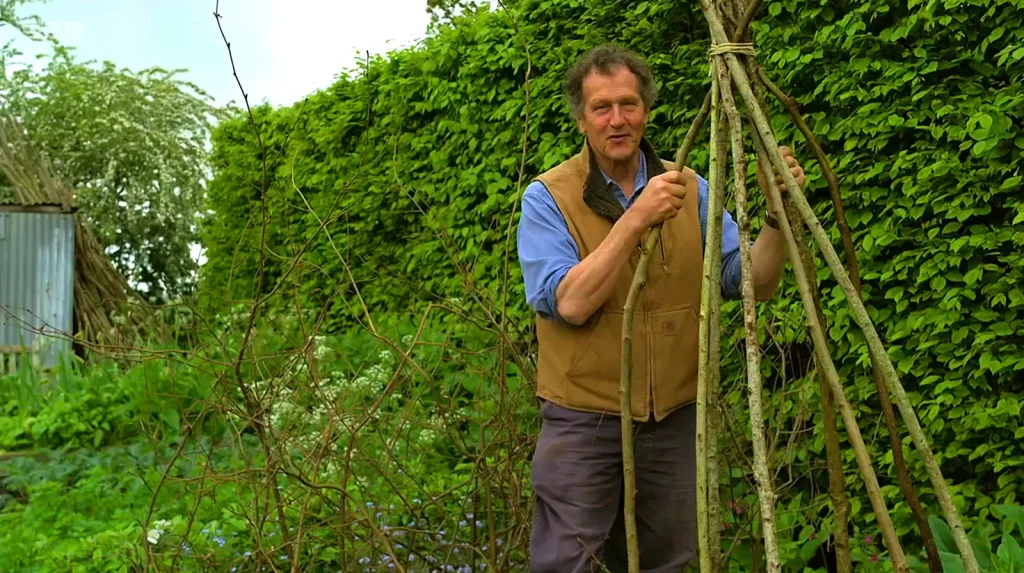Gardeners World 2024 Episode 22: As we approach the vibrant month of September, the anticipation of a new gardening season stirs Monty Don into action. In this 22nd episode of Gardeners’ World 2024, Monty turns his thoughts to the future, laying the groundwork for next year’s floral displays. Among his tasks is the exciting addition of foxtail lilies to his borders, a choice that promises to bring striking vertical accents and a splash of color to his garden next summer. Known for their tall, elegant spires of flowers, these lilies are a testament to Monty’s keen eye for plants that not only beautify but also enhance the structure and rhythm of the garden.
But Monty’s forward-thinking approach isn’t limited to just flowers. The winter salads he sowed in the previous month are now robust enough to be planted out, offering a taste of the cool-season harvests to come. These greens, which thrive in the colder months, are a staple for any gardener looking to extend their growing season. Monty’s careful planning and timely sowing are showcased as he transitions these young plants from greenhouse to garden bed, ensuring a steady supply of fresh produce even as the days grow shorter.
In the controlled environment of his greenhouse, Monty faces a different challenge: the persistent and troublesome fuchsia gall mite. This tiny pest, notorious for deforming fuchsia plants, poses a significant threat to Monty’s carefully nurtured collection. The dilemma of how to tackle this issue head-on is a reminder of the constant vigilance required in gardening, where pests and diseases are as much a part of the landscape as the plants themselves. Monty’s expertise and problem-solving skills come to the fore as he shares strategies for managing this pesky invader, offering viewers practical advice for keeping their own fuchsias healthy and thriving.
Meanwhile, Rachel de Thame takes viewers on a fascinating journey into the intricate world of bees and the vital role they play in pollination. Her exploration goes beyond the garden, delving into the science that underpins this essential process. Rachel uncovers the complex relationships between bees and the plants they pollinate, revealing how these tiny insects are crucial to the production of many of the foods we enjoy. Through her eyes, we gain a deeper appreciation for the interconnectedness of nature and the importance of fostering environments where pollinators can thrive.
In the bustling heart of London, Arit Anderson discovers a hidden gem—a green oasis that stands as a testament to the power of texture and form in garden design. This urban sanctuary, nestled among the city’s concrete and steel, showcases how carefully chosen plants and thoughtful landscaping can transform even the smallest spaces into havens of tranquility. Arit’s visit highlights the creativity and innovation required to make the most of urban gardens, where every square inch counts. The garden she explores is a masterclass in using texture and form to create visual interest and a sense of depth, offering inspiration for anyone looking to bring a touch of nature into the city.
Gardeners World 2024 Episode 22
Back in the picturesque town of Ross-on-Wye, we meet a gardener whose passion for horticulture is undeterred by the challenges of working on a sloped garden. Diagnosed with osteoarthritis at a young age, this determined individual has adapted their gardening techniques to suit their unique circumstances. Their story is one of resilience and innovation, demonstrating that with the right tools and mindset, physical limitations need not be a barrier to enjoying the joys of gardening. The garden itself, with its cascading terraces and carefully planned beds, is a testament to the gardener’s skill and perseverance, offering valuable lessons in how to garden on uneven terrain.
In Shropshire, we visit a pair of enthusiastic growers who have recently discovered a deep passion for daylilies. Their newfound love for these versatile and hardy perennials has led them to create a stunning collection that showcases the incredible variety within the species. From vibrant yellows to rich purples, their daylily garden is a riot of color that demonstrates the plant’s ability to thrive in a range of conditions. Their journey into the world of daylilies is a reminder of the endless possibilities that gardening offers, and how a single plant can open the door to a lifelong hobby.
Throughout this episode, Gardeners’ World continues to inspire and educate, offering viewers a rich tapestry of gardening knowledge and personal stories. Whether you’re planning for the future like Monty, tackling pests in the greenhouse, or finding joy in unexpected places, this episode reminds us that gardening is not just about the plants—it’s about the people, the places, and the connections we make along the way. As the seasons change and the garden evolves, so too does our understanding and appreciation of the natural world around us.
Gardeners World 2024 Episode 22: The Magic of Late Summer in the Garden
Setting the scene: A vibrant September garden
As the golden rays of September sun caress your garden, a symphony of colors and textures unfolds before your eyes. The air is filled with a gentle warmth, carrying the sweet fragrance of late-blooming flowers and the earthy scent of ripening fruits. It’s as if nature is throwing one last grand party before the arrival of autumn.
Imagine strolling through your garden, the soft grass tickling your bare feet. You pause to admire a cluster of vibrant dahlias, their petals unfurling like miniature fireworks. Nearby, a chorus of bees hums contentedly as they flit from flower to flower, their tiny bodies heavy with pollen. This is the magic of late summer in the garden – a time of abundance, transition, and hidden wonders.
The changing colors and textures of grass borders
As you continue your garden walk, your attention is drawn to the grass borders. Once a uniform sea of green, they’ve now transformed into a captivating tapestry of colors and textures. Tall, feathery plumes of ornamental grasses sway gently in the breeze, their colors shifting from deep greens to warm golds and bronzes.
Interspersed among the grasses, late-blooming perennials add pops of color. The fiery oranges of heleniums dance alongside the regal purples of asters, while the architectural seed heads of fennel and eupatorium provide structure and interest. This ever-changing display is nature’s way of reminding us that beauty can be found in every stage of growth and decay.
Teasing the upcoming topics: From lavender pruning to pollinator science
But the late summer garden isn’t just a feast for the eyes – it’s also a hive of activity and opportunity. As you breathe in the crisp air, your mind begins to wander to the tasks at hand. The lavender bushes, having finished their spectacular summer show, now need your attention to ensure a healthy growth cycle for next year.
Your gaze drifts to the vegetable patch, where squash and pumpkin vines sprawl with wild abandon. Their exuberant growth is both a blessing and a challenge, requiring careful management to ensure a bountiful harvest. And as you watch a bumblebee navigate the intricate petals of a foxglove, you can’t help but marvel at the complex dance between plants and pollinators – a fascinating world of evolutionary adaptations waiting to be explored.
The late summer garden is a place of both reflection and anticipation. It invites us to pause and appreciate the beauty of the present moment while also looking ahead to the changes and opportunities that the coming seasons will bring. So, let’s roll up our sleeves and dive into the joys and challenges of gardening in this magical time of year.
Essential Late Summer Garden Tasks
Lavender care: Timing and techniques for pruning
As the late summer sun bathes your garden in a warm glow, your lavender bushes stand as fragrant sentinels, their once-vibrant blooms now faded. But don’t be fooled by their seemingly dormant appearance – now is the perfect time to give these aromatic beauties the attention they deserve. Proper pruning is the key to ensuring your lavender plants remain healthy, vigorous, and ready to put on a spectacular show next year.
Why prune now, you might ask? Well, timing is everything in the garden. By cutting back your lavender after flowering but before the first frost, you’re giving the plants a chance to put on a bit of new growth. This fresh foliage will harden off before winter, making your lavender more resilient to cold weather. Moreover, pruning now helps maintain the plant’s shape and prevents it from becoming woody and unproductive.
Proper cutting techniques to avoid damaging old wood
When it comes to pruning lavender, a gentle touch is crucial. Think of it as giving your plant a stylish haircut rather than a severe buzz cut. Start by removing the spent flower stalks, cutting them back to the first set of leaves. Then, shape the plant by trimming about one-third of the current year’s growth. Remember, lavender doesn’t regenerate from old wood, so always leave some green growth on each stem.
As you prune, take a moment to appreciate the therapeutic nature of this task. The rhythmic snipping of your secateurs, combined with the released lavender fragrance, can be wonderfully calming. It’s a perfect opportunity to connect with your plants and reflect on the season’s successes.
Managing overgrown squash and pumpkin plants
Turn your attention now to the vegetable patch, where your squash and pumpkin vines have likely transformed into a sprawling jungle. These exuberant plants, with their large leaves and twisting tendrils, can quickly overwhelm a garden. However, with some strategic pruning and training, you can tame this unruly growth and maximize your harvest.
First, identify the main vines and gently redirect them to grow in the desired direction. This might involve carefully lifting and repositioning the vines or using supports to guide their growth. As you do this, keep an eye out for any damaged or diseased sections – these should be promptly removed to prevent issues from spreading.
Focusing energy on ripening existing fruit
Now comes the tough love part of squash management – removing excess growth. It might feel counterintuitive to cut away seemingly healthy parts of the plant, but remember, your goal is quality over quantity. By selectively pruning, you’re redirecting the plant’s energy towards ripening the existing fruit rather than producing more that won’t have time to mature.
Start by pinching off the growing tips of the main vines. This will halt their expansion and encourage the plant to focus on fruit development. Next, remove any small, immature fruits that are unlikely to reach maturity before the first frost. It’s a bit like choosing the star performers in a play – you’re giving the best fruits the spotlight they need to shine.
Preparing for autumn: Sowing yellow rattle in meadows
As the days grow shorter, it’s time to look ahead and lay the groundwork for next year’s wildflower display. Enter yellow rattle, the unsung hero of meadow ecosystems. This humble plant plays a crucial role in creating diverse, vibrant wildflower meadows by naturally suppressing grass growth.
Sowing yellow rattle now gives the seeds the cold period they need to germinate successfully in spring. To start, choose an area of your garden where you’d like to establish or enhance a wildflower meadow. Prepare the ground by mowing the existing vegetation very short and raking to create patches of bare soil.
Proper sowing techniques and timing
Scatter the yellow rattle seeds thinly over the prepared area. Don’t be tempted to sow too densely – these plants know how to make the most of their space. After sowing, lightly rake the area to ensure good seed-to-soil contact. There’s no need to cover the seeds, as they need light to germinate.
As you sow, imagine the transformation these tiny seeds will bring. Come spring, they’ll emerge as delicate plants with yellow, beak-like flowers that rattle in the breeze – hence their charming name. By weakening the surrounding grasses, yellow rattle creates space for a diverse array of wildflowers to thrive, turning your meadow into a buzzing, blooming haven for wildlife.
The Hidden World of Plant-Pollinator Relationships
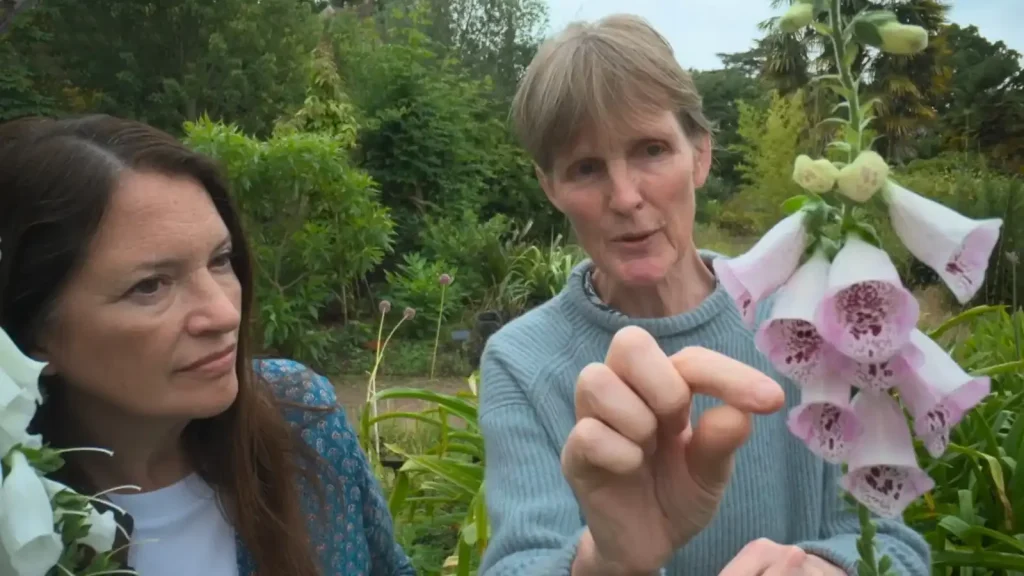
The evolutionary dance between flowers and insects
Imagine a time-lapse video spanning 70 million years, showing flowers and insects evolving in perfect synchronicity. This isn’t science fiction; it’s the fascinating reality of plant-pollinator relationships. Over eons, flowers and their insect partners have engaged in an intricate dance of adaptation, each step bringing mutual benefits and incredible complexity.
Consider the humble foxglove, for instance. Its bell-shaped flowers aren’t just pretty; they’re precision-engineered landing pads for bees. As a bee enters the flower, it follows a path laid out by evolution, brushing against pollen-laden stamens before reaching the sweet nectar reward at the base. But here’s the clever part: the foxglove offers more nectar in its lower flowers, which are ready for pollination, than in the upper ones, which are still producing pollen. This ingenious strategy ensures that pollen from one plant is likely to be carried to another, promoting genetic diversity.
Surprising adaptations flowers use to attract pollinators
You might think you know flowers, but prepare to be amazed by their hidden talents. Some flowers, believe it or not, can generate heat! It’s like they’re offering a cozy blanket to cold-blooded insects. This warmth serves a dual purpose: it makes the flower more attractive to pollinators and helps release fragrant compounds more effectively. Next time you see a bee lingering in a flower on a chilly morning, remember – it might be enjoying nature’s version of a heated seat!
But the surprises don’t stop there. Take a closer look at a rose petal, and you’ll find it’s not as smooth as it appears. Under a microscope, the surface is covered in tiny, conical cells. These cells act like miniature climbing holds for insects, giving them a secure grip as they go about their pollination duties. It’s nature’s way of rolling out the red carpet for its most important guests.
The science behind flower memory and pollinator preferences
Did you know that flowers can influence an insect’s memory? It sounds like something out of a sci-fi novel, but it’s pure, fascinating science. Some flowers, including coffee and citrus blossoms, add a dash of caffeine to their nectar. This botanical espresso shot doesn’t just give bees a buzz; it actually enhances their memory of the flower’s scent and location. Talk about a clever marketing strategy!
But the floral world’s ingenuity doesn’t stop at chemical tricks. Many flowers have evolved intricate patterns visible only under ultraviolet light – a secret code that’s invisible to our eyes but crystal clear to bees. These patterns, often forming bull’s-eye designs, guide pollinators straight to the nectar source. It’s like nature’s version of airport runway lights, ensuring a perfect landing every time.
By understanding these hidden relationships, we gain a deeper appreciation for the complexity of nature. Every garden, no matter how small, is a stage for this ongoing evolutionary performance. So next time you’re tending to your flowers, take a moment to observe the busy pollinators. You’re witnessing the result of millions of years of co-evolution, a testament to nature’s endless creativity and adaptability.
Conclusion Gardeners World 2024 Episode 22: Embracing the Wonders of Your Late Summer Garden
Recap of key tasks and insights
As the golden hues of late summer paint your garden, it’s time to reflect on the wealth of knowledge we’ve uncovered. From the delicate art of lavender pruning to the strategic management of exuberant squash vines, we’ve journeyed through essential tasks that will set your garden up for success. Remember, timing is everything in gardening. By pruning your lavender now, you’re not just tidying up; you’re ensuring a vibrant display for next year.
Moreover, we’ve delved into the fascinating world of plant-pollinator relationships. Who would have thought that flowers could be such clever marketers? With their heat-producing abilities and caffeine-laced nectar, they’ve developed strategies that would make any advertising executive green with envy. These insights don’t just satisfy our curiosity; they deepen our connection to the natural world around us.
Encouraging readers to observe and appreciate the intricate relationships in their gardens
Now, armed with this knowledge, it’s time to look at your garden with fresh eyes. Next time you step outside, pause for a moment. Watch a bee as it navigates the intricate landscape of a flower. Notice how it follows invisible patterns, guided by colors we can’t see and scents we can barely detect. This isn’t just pollination; it’s a dance that’s been perfected over millions of years.
Consider setting up a comfortable spot in your garden where you can sit and observe. It could be a bench nestled among your flowers or a cozy chair on your patio. From this vantage point, you’ll have a front-row seat to nature’s most spectacular show. Keep a journal nearby to jot down your observations. You might be surprised at the patterns you notice over time.
Looking ahead: Preparing for the transition to autumn
As we savor these last moments of summer, it’s also time to look ahead. The garden is always in transition, and autumn brings its own set of joys and challenges. Start thinking about which plants you might want to divide or move as the weather cools. Perhaps there’s a corner of your garden that could use a splash of fall color. Why not plan to add some late-blooming asters or vibrant chrysanthemums?
Don’t forget about your soil, the unsung hero of any garden. As leaves begin to fall, consider starting a compost pile if you haven’t already. Those autumn leaves, combined with your kitchen scraps, will decompose over winter to create rich, nutritious compost for next spring’s planting. It’s nature’s way of recycling, and your plants will thank you for it.
Remember, gardening is a journey, not a destination. Each season brings new opportunities to learn, grow, and connect with the natural world. So embrace the changes, celebrate the successes, and learn from the challenges. Your late summer garden is a living testament to the beauty and resilience of nature. Cherish it, nurture it, and most importantly, enjoy every moment you spend in it. Happy gardening!
F.A.Q. Gardeners World 2024 Episode 22
Q.: What is the focus of Gardeners’ World 2024 Episode 22?
A.: Gardeners’ World 2024 Episode 22 focuses on preparing for the next gardening season as Monty Don lays the groundwork for next year’s floral displays. The episode also covers various gardening tasks, such as planting foxtail lilies, managing winter salads, and dealing with the fuchsia gall mite. Additionally, it explores the intricate relationships between plants and pollinators, and offers inspiration for urban gardening.
Q.: Why does Monty Don choose to plant foxtail lilies in this episode?
A.: Monty Don chooses to plant foxtail lilies in this episode because they provide striking vertical accents and add a splash of color to the garden. These lilies are known for their tall, elegant spires of flowers, which not only beautify the garden but also enhance its structure and rhythm, making them an excellent addition to any floral border.
Q.: How does Gardeners’ World address the issue of pests in this episode?
A.: In this episode, Monty Don tackles the challenge of dealing with fuchsia gall mites, a persistent pest known for deforming fuchsia plants. Monty shares his expertise and strategies for managing this pest, offering practical advice to viewers on how to keep their fuchsias healthy and thriving despite the threat.
Q.: What is Rachel de Thame’s segment about in this episode?
A.: Rachel de Thame’s segment in this episode explores the fascinating world of bees and their crucial role in pollination. She delves into the science behind how bees interact with plants, revealing the intricate relationships that are vital for the production of many foods we enjoy. This segment highlights the importance of creating environments where pollinators can thrive.
Q.: How does Arit Anderson contribute to the episode?
A.: Arit Anderson contributes to the episode by discovering a hidden green oasis in the heart of London. She highlights the creativity and innovation required to make the most of urban gardens, showcasing how texture and form can transform even the smallest spaces into tranquil havens. Her segment offers valuable inspiration for anyone interested in urban gardening and landscape design.2
